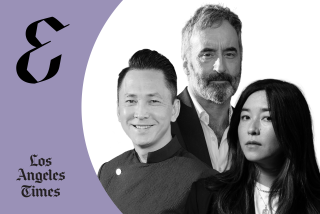Cameraman turns his lens on his peers
Owen Roizman has spent his career behind a camera, first as the five-time Oscar-nominated cinematographer of such classics as 1971’s “The French Connection,” 1973’s “The Exorcist” and 1976’s “Network” and for the last 14 years as a still portrait photographer. In fact, he says he never travels without a digital camera in his pocket just in case he meets an interesting face.
It was photographer Douglas Kirkland who introduced Roizman, 74, to the world of digital photography and software such as Adobe Photoshop. “When I got my first digital camera I used to walk around and stick it in [people’s faces],” Roizman says.
Those early photographs and experimentation with Photoshop led to him taking photographs of his fellow cinematographers for the “Member Portrait” that appears every month in American Cinematographer magazine. More than 100 of these evocative portraits are on display at the Academy of Motion Picture Arts and Sciences Grand Lobby through April 17.
Among the cinematographers captured for the “Masters of the Close-Up, Up Close” are Caleb Deschanel, John Toll, Bill Dill, Daryn Okada, Rodney Taylor, Ellen Kuras and Nancy Schreiber.
It’s hard to miss the fact that there are only three women in the show. “We don’t have many women in the [American Society of Cinematographers],” Roizman acknowledges, sitting in the Academy lobby surrounded by his work. “If there are female cinematographers around and they are doing quality work, they will get invited into the ASC.”
Being a cinematographer was a collaborative effort with a director, but he answers to no one when he shoots the portraits. “I sit the person down and I talk to them and I look at their face and figure out how they are going to look best in what light and how I am going to catch his personality,” Roizman says.
The Brooklyn-born Roizman grew up surrounded by cameras. His father, Sol, was a cinematographer for Fox Movietone News, and his uncle Morris was an editor. After graduating from Gettysburg College in Pennsylvania, he began his career as an assistant cameraman in commercials, eventually working his way up to cinematographer. He got his break in a low-budget 1970 film, “Stop,” that was seen by virtually no one save for “French Connection” director William Friedkin and the thriller’s producer Phil D’Antoni.
“Friedkin said, ‘I like your work in it; what I want to do … what I want it to be is a realistic street photography sort of thing.’ I said, ‘Why not? I should be able to do anything you tell me. I’m a cinematographer.’ He liked my attitude.”
Roizman said that “The French Connection” was the product of his close artistic partnership with Friedkin. “Billy did a great job, and I just was trying to give it a look, something that would enhance it. We talked about camera movement and how we wanted to have an uneasy feeling in certain scenes and definitely that realism all the time.”
The most difficult sequence to shoot in the film was the seminal car chase through the mean streets of New York as hard-nosed New York Det. Popeye Doyle (Oscar-winning Gene Hackman) commandeers a civilian car and tries to keep up with the hit man who is attempting an escape on an elevated train.
“It was done in two different ways,” Roizman says. “Three cameras were used inside the car, including a camera on the dashboard that would look out through the windshield and one over the driver’s shoulder. From the outside, we had five cameras. We broke it down to five stunts, and the rest of it was just bits and pieces. For each of the stunts we had five cameras set up at different angles to cover it all.
“We only tried to do it once because the car was going to get wrecked. The whole chase, including the interior of the subways, I think was about five weeks.”
More to Read
The biggest entertainment stories
Get our big stories about Hollywood, film, television, music, arts, culture and more right in your inbox as soon as they publish.
You may occasionally receive promotional content from the Los Angeles Times.











